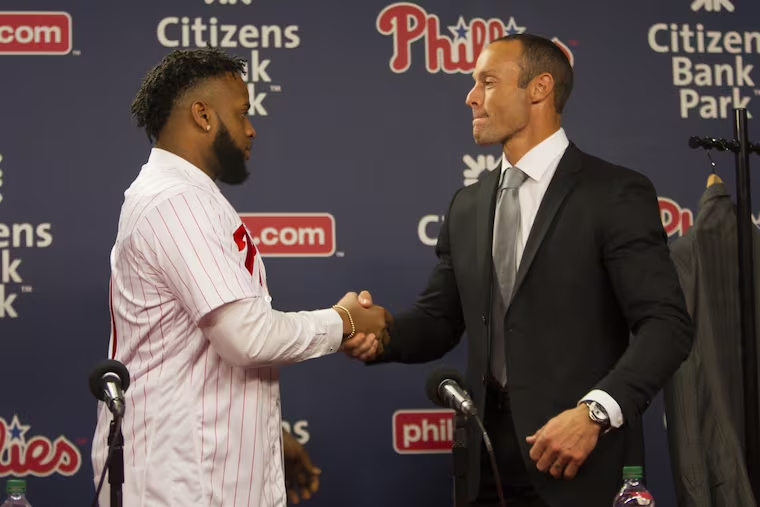How the Phillies landed Carlos Santana, their biggest signing in years
It was the first real test of Phillies general manager Matt Klentak's ability to pitch a major player on why his vision was the right one. Santana, for $60 million, bought into it.

The Phillies had completed their agreements with two veteran relievers and forged a handshake deal on a trade for their Rule 5 pick, so Matt Klentak booked an early flight home Dec. 13 from baseball's winter meetings in Florida.
Before that, he had another meeting.
Klentak had received a text message and a phone call earlier that day from Ulises Cabrera, the agent for Carlos Santana. The general manager and agent had stayed in touch ever since free agency began. None of the talks was ever too serious. Now, Cabrera told Klentak that a three-year deal could work. But the sides had yet to discuss money. So, after the meeting in a Disney World hotel suite, Klentak headed for the Orlando airport.
"It didn't seem to me," he said Wednesday after a news conference to introduce the Phillies' biggest free-agent signing in seven years, "that the Santana thing was going to happen that quickly."
The Phillies liked Santana because he epitomized what they have sought in a player — someone who reaches base at an elite rate and adds value as a defender. Santana had spent almost a decade with the Cleveland Indians and came within an inning of winning the World Series.
The first baseman was surprised that the Phillies — the team with the fewest wins in baseball since 2012 — had interest in him. Cabrera relayed to his client what he believed to be a viable path to contention, explained in detail by Klentak. The two reliever contracts for $34 million given to Pat Neshek and Tommy Hunter provided further proof.
Santana told his agent to talk money with the Phillies.
Cabrera called Klentak at around 10:30 p.m. on Dec. 13. Klentak was at the airport. He boarded the plane home with a few ideas and some increased confidence this could happen. They talked more Thursday, with Klentak juggling calls to complete a fast-moving trade of shortstop Freddy Galvis to San Diego. News of the deal leaked Friday afternoon. The Phillies were willing to pay a premium for a shorter term.
That is how the Phillies landed a $60 million free agent for the first time since pitcher Cliff Lee signed between the 2010 and 2011 seasons.
It was the first real test of Klentak's ability to pitch a major player on why his vision was the right one.
Santana, for $60 million, bought into it.
"We were honest with him," Klentak said. "We are genuinely excited about this organization's future. You've heard me talk about it a lot this offseason — about the strides we believe we made in the second half last year, about the quality of our farm system, about our ownership's commitment. We basically told him the truth from the very beginning. We told him why we thought he was a good fit here."
Santana and his agent needed to hear a little more than that. Both Boston and Cleveland, two teams with higher expectations for 2018, had engaged Santana's camp in talks. Santana will turn 32 in April. His Indians teams had averaged 90 wins in the last five seasons. He does not know how many more chances he will have to play for a ring.
There were no delusions of immediate grandeur.
"Are they going to win 90 games next year? Probably not," Cabrera said. "Are they in a direction to? Yes. We felt that. That was a key component of this whole process."
They came to that conclusion through Klentak's outlined plan, which both sides declined to discuss in detail.
"What really struck us was Matt's conviction," said Cabrera, who works at Octagon. "The tone of his voice when he says, 'Hey, we're going to win. The Phillies are going to win.' That was really the biggest obstacle in Carlos considering this as possibility."
The money was a factor, as it always is. About two dozen position players in the history of the game have been paid an average annual value of $20 million. That commitment, Santana's agent said, demonstrated how serious the Phillies were about putting Santana in "a different stratosphere."
The Phillies were comfortable with it over three years. The deal is front-loaded; they paid Santana a $10 million signing bonus. It includes a club option for $17.5 million with a $500,000 buyout, according to a source. There is not a no-trade clause in the contract.
"We're trying to minimize the downside while maximizing the upside," Klentak said.
The deal surprised Santana and the industry. It will move Rhys Hoskins to leftfield and displace another young outfielder, who could be on the bench or part of a trade for a starting pitcher. It raises the expectations.
It is a blueprint for how the Phillies could woo more big-money talent in the coming winters.
"They are rewarding him for things that, maybe historically, aren't necessarily rewarded," Cabrera, the agent, said. "You're talking about a guy who doesn't jump out as a big home-run guy. But you look at what the Astros have done to turn their team into a winner — they increased their on-base percentage, they reduced their strikeout rate, they increased their defensive runs saved — that's exactly what Carlos does. [The Phillies'] analytical group identified those key components. That's why they were as aggressive as they were."
Santana, after answering a few questions, posed for a photo with his family in the basement of Citizens Bank Park. He tugged on his red Phillies hat and joked with his new manager, Gabe Kapler, about what time their morning workouts should begin.
"I'm excited," Santana said. "I know the Phillies have a lot of young players. I signed here because the Phillies want me. They believe in me."